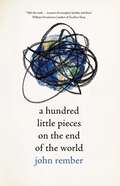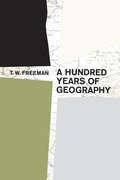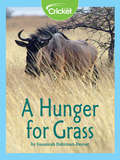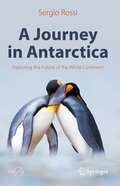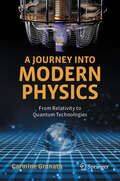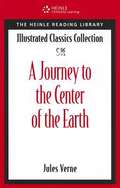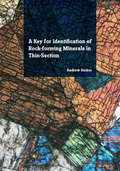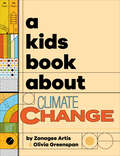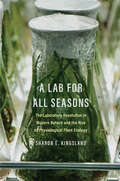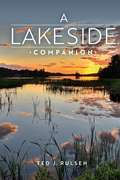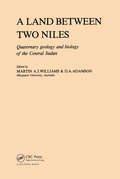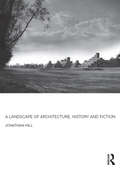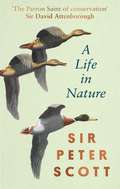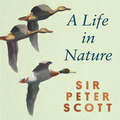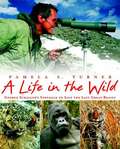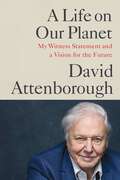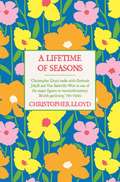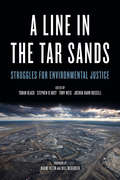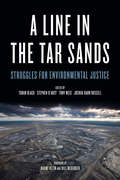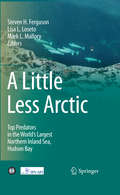- Table View
- List View
A Hundred Little Pieces on the End of the World
by John RemberWritten with clarity, tenacity, humor, and warmth, A Hundred Little Pieces on the End of the World attempts to find tolerable ethical positions in the face of barely tolerable events—and the real possibility of an intolerable future. It is a compelling, surprising, disturbing, and highly literate work of reportage and contemplation. It is both a collection of gentle-spirited wisdom and a rumination on ruin, as if distilled in equal measure from the spirits of Norman Maclean&’s A River Runs Through It and Cormac McCarthy&’s The Road.Through these ten essays, each further broken into ten smaller pieces, Rember examines the practical and ethical dilemmas of climate change, population, resource depletion, and mass extinction. At the same time, he never forgets those improbable connections between human beings that lead to moments of joy, empathy, and grace.
A Hundred Years of Geography
by T.W. FreemanFar from dissolving, this effort demonstrates the ongoing vitality of geography as a profession. In a world increasingly sensitive to the problems of people and resources, geography has constantly provided the basic information for its sister sciences, economics, political science, sociology and demography, This book turns, attention to geography itself, in an incisive survey of the development of the discipline as a science. "A Hundred Years of Geography" draws together the threads of a century of progress, from the first scientific explorations and mappings to present-day trends toward specialization and generalization. It contains a synoptic view of the development of the various aspects of geography, showing how the field has been differentiated from associated disciplines and how it has differentiated and specialized within itself. The book also offers two important reference tools: a bibliography of the important geographical works published throughout the world, and biographical sketches of ninety important geographers. It is informative, stimulating, urbane and civilized reading, as well as being an excellent introductory text and reference work to recent scholarship in the field of geography.
A Hunger for Grass
by Susannah Buhrman-DeeverThe wildebeests of the Serengeti follow the grass as it grows throughout the year.
A Journey in Antarctica: Exploring the Future of the White Continent (Springer Praxis Books)
by Sergio RossiHaving always been fascinated by these singular landscapes, Sergio Rossi reconstructs some of the episodes that have marked the exploration of these territories, such as the dramatic race between Amundsen and Scott to conquer the South Pole, and Captain Shackleton’s odyssey to save his crew from certain death. But also modern trips including his own to these remote areas, explaining many aspects of the current science and political competition that is underway. The book leads us on an entertaining overview of all the problems and opportunities that the planet’s most forgotten continent offers to humans. A remote mass of ice upon which our future as a species depends and which we cannot continue to ignore any longer.
A Journey into Modern Physics: From Relativity to Quantum Technologies
by Carmine GranataThis book offers a short journey into the surprising and spectacular world of modern physics characterized by disruptive ideas and theory from both a conceptual and applicative point of view. Starting from Einstein's theory of relativity in which the concepts of space, time, and gravity are completely revised, before arriving at the bizarre and fascinating universe of quantum physics which with its applications has completely changed our way of life. Particular attention is also paid to the conceptual foundations and paradoxes of quantum mechanics thanks to which the so-called second quantum revolution has developed in more recent times, destined to introduce a new generation of quantum technologies such as computers, cryptography, and teleportation into our lives. In addition to new quantum technologies, the operating principles of the most important applications of quantum mechanics which have become widespread in everyday life are illustrated simply and concisely. The book has an essentially informative character, without making use of complicated formulas or technicalities, therefore it does not require in-depth knowledge of physics or mathematics; the knowledge acquired in high school is sufficient to understand the topics covered.
A Journey to the Center of the Earth (Great Illustrated Classics)
by Jules Verne Howard J. SchwachIt's a race to the ultimate frontier -- the very interior of the earth itself. Join Young Harry, his uncle Hardwigg, and their other companions as they climb down the sleeping volcano that will bring them to the unknown terrain beneath the earth's crust. At every step, unimagined dangers await them -- and footstep could be the last. And the deeper they go, the deeper the mystery of who may have been there before them!" Adapted by Howard J. Schwach
A Key for Identification of Rock-Forming Minerals in Thin Section
by Andrew J. BarkerStructured in the form of a dichotomous key, comparable to those widely used in botany, the mineral key provides an efficient and systematic approach to identifying rock-forming minerals in thin-section. This unique approach covers 150 plus of the most commonly encountered rock-forming minerals, plus a few rarer but noteworthy ones. Illustrated in full colour, with 330 plus high quality mineral photomicrographs from a worldwide collection of igneous, metamorphic, and sedimentary rocks, it also provides a comprehensive atlas of rock-forming minerals in thin-section.Commencing with a brief introduction to mineral systems, and the properties of minerals in plane-polarised and cross-polarised light, the mineral key also includes line drawings, tables of mineral properties and an interference colour chart, to further aid mineral identification. To minimise the chance of misidentification, and enable less experienced petrologists to use the key with confidence, the key has been arranged to prioritise those properties that are most easily recognised.Designed for simplicity and ease of use, it is primarily aimed at undergraduate and postgraduate students of mineralogy and petrology, but should also provide a valuable source of reference for all practising geologists dealing with rock thin sections and their interpretation.
A Kids Book About Climate Change: Kids Are Ready (A Kids Book)
by Zanagee Artis Olivia GreenspanExplore the impact of climate change and empower kids to be proactive to protect our world.This is a kid's book about climate change. Climate change is a topic that can be overwhelming for kids and grownups. So if you're looking for the best place to better understand the climate crisis, look no further!This book helps kids aged 5-9 understand what climate change means, giving them the power to make a difference. Learn the facts about climate change, explain what the state of our planet is, how it got there, and give them hope to fight for their future.A Kids Book About Climate Change features: - A large and bold, yet minimalist font design that allows kids freedom to imagine themselves in the words on the pages.- A friendly, approachable and empowering, kid-appropriate tone throughout.- An incredible and diverse group of authors in the series who are experts or have first-hand experience of the topic.Tackling important discourse together! The A Kids Book About series are best used when read together. Helping to kickstart challenging, empowering, and important conversations for kids and their grownups through beautiful and thought-provoking pages. The series supports an incredible and diverse group of authors, who are either experts in their field, or have first-hand experience on the topic. A Kids Co. is a new kind of media company enabling kids to explore big topics in a new and engaging way. With a growing series of books, podcasts and blogs, made to empower. Learn more about us online by searching for A Kids Co.
A Kinetic View of Statistical Physics
by Pavel L. Krapivsky Sidney Redner Eli Ben-NaimAimed at graduate students, this book explores some of the core phenomena in non-equilibrium statistical physics. It focuses on the development and application of theoretical methods to help students develop their problem-solving skills. The book begins with microscopic transport processes: diffusion, collision-driven phenomena, and exclusion. It then presents the kinetics of aggregation, fragmentation and adsorption, where the basic phenomenology and solution techniques are emphasized. The following chapters cover kinetic spin systems, both from a discrete and a continuum perspective, the role of disorder in non-equilibrium processes, hysteresis from the non-equilibrium perspective, the kinetics of chemical reactions, and the properties of complex networks. The book contains 200 exercises to test students' understanding of the subject. A link to a website hosted by the authors, containing supplementary material including solutions to some of the exercises, can be found at www. cambridge. org/9780521851039.
A Kitchen Course in Electricity and Magnetism
by David Nightingale Christopher SpencerElectricity is all around us: cars, telephones, computers, lights -- the modern world runs entirely on electrons. But what are electrons? How do they behave? How do we control them? This book will show you how to build a battery, detect static electricity and construct a basic current meter, all using common items from your kitchen. Along the way you'll learn about the meaning of "voltage" and "current", what makes an LED work and the difference between AC and DC. The last chapter uses transistors -- the basic building blocks of every computer -- for lots of interesting experiments. With plenty of colorful illustrations, historical stories and an easy, accessible style, "A Kitchen Course in Electricity and Magnetism" will be a great start for budding and amateur scientists who want to learn more about how the world works.
A Lab for All Seasons: The Laboratory Revolution in Modern Botany and the Rise of Physiological Plant Ecology
by Sharon E. KingslandThe first book to chronicle how innovation in laboratory designs for botanical research energized the emergence of physiological plant ecology as a vibrant subdiscipline Laboratory innovation since the mid-twentieth century has powered advances in the study of plant adaptation, evolution, and ecosystem function. The phytotron, an integrated complex of controlled-environment greenhouse and laboratory spaces, invented by Frits W. Went in the 1950s, set off a worldwide laboratory movement and transformed the plant sciences. Sharon Kingsland explores this revolution through a comparative study of work in the United States, France, Australia, Israel, the USSR, and Hungary. These advances in botanical research energized physiological plant ecology. Case studies explore the development of phytotron spinoffs such as mobile laboratories, rhizotrons, and ecotrons. Scientific problems include the significance of plant emissions of volatile organic compounds, symbiosis between plants and soil fungi, and the discovery of new pathways for photosynthesis as an adaptation to hot, dry climates. The advancement of knowledge through synthesis is a running theme: linking disciplines, combining laboratory and field research, and moving across ecological scales from leaf to ecosystem. The book also charts the history of modern scientific responses to the emerging crisis of food insecurity in the era of global warming.
A Lakeside Companion
by Ted J. RulsehWhy do fish jump? Why don't lakes freeze all the way down to the bottom? Which lake plants are invasive? What are those water bugs? Is that lake healthy? Whether you fish, paddle, swim, snowshoe, ski, or just gaze upon your favorite lake, A Lakeside Companion will deepen your appreciation for the forces that shape lakes and the teeming life in and around them. You'll discover the interconnected worlds of a lake: the water; the sand, gravel, rocks, and muck of the bottom; the surface of the lake; the air above; and the shoreline, a belt of land incredibly rich in flora and fauna. Explained, too, are the physical, biological, and chemical processes that determine how many and what kinds of fish live in the lake, which plants grow there, the color and clarity of the water, how ice forms in winter and melts in spring, and much more. Useful advice will help you look out for your lake and advocate for its protection.
A Land Between Two Niles: Quaternary geology and biology of the Central Sudan
by Martin A.J. Williams; D.A.AdamsonThree themes run through this book, the first is the history of the Nile; the second is the degree to which the present Sudanese landscape reflects the operation of former geological processes; the third is the interaction between man and environment, not always to the benefit of either. A land between two Niles is an interdisciplinary account of the origins and characteristics of the alluvial plains of the lower Blue and White Nile. The contributors have focussed their attention upon this region for several reasons. Although the Gezira plain itself only occupies about one percent of the total area of the Sudan, the high quality long-staple cotton grown there provides nearly two-thirds of the country’s total export revenue.
A Landscape of Architecture, History and Fiction
by Jonathan HillArchitecture can be analogous to a history, a fiction, and a landscape. We expect a history or a novel to be written in words, but they can also be cast in concrete or seeded in soil. The catalyst to this tradition was the simultaneous and interdependent emergence in the eighteenth century of new art forms: the picturesque landscape, the analytical history, and the English novel. Each of them instigated a creative and questioning response to empiricism’s detailed investigation of subjective experience and the natural world, and together they stimulated a design practice and lyrical environmentalism that profoundly influenced subsequent centuries. Associating the changing natural world with journeys in self-understanding, and the design process with a visual and spatial autobiography, this book describes journeys between London and the North Sea in successive centuries, analysing an enduring and evolving tradition from the picturesque and romanticism to modernism. Creative architects have often looked to the past to understand the present and imagine the future. Twenty-first-century architects need to appreciate the shock of the old as well as the shock of the new.
A Less Green and Pleasant Land
by Norman MacleanDisentangling the facts from the hype, this 'Domesday book' of the British and Irish countryside offers a definitive and up-to-date survey of the state of our wildlife today. Norman Maclean, editor of the bestselling Silent Summer, examines the latest findings of Britain and Ireland's top wildlife experts and interprets them for a wider audience. Each chapter provides reliable estimates of animal populations, showing which species are thriving and which are in decline. The book also considers the effects of climate change on our wildlife and how human population growth is influencing its development. Beautifully illustrated with colour plates and wood engravings throughout, this accessible and timely study reveals just how rapidly our countryside and its wildlife are changing, why we should be concerned, and what we can do about it.
A Life In Nature
by Peter Scott'The Patron Saint of Conservation' Sir David Attenborough'Peter Scott was a huge influence on my childhood...Later on in life I had the good fortune both to meet and to interview him, and he remains, for me, a hero. His knowledge, his kindness to me and his generosity of spirit have remained an influence in my own sphere of natural history....To meet one's heroes can sometimes be a let-down. That was most certainly not the case with Peter Scott.' Alan TitchmarshA Life In Nature is a portrait of Peter Scott collected from his own conversations, articles and broadcasts including thoughts on expeditions to Lapland, Conservation and Africa, his travels in Europe and much more. Illustrated by Peter's own beautiful illustrations. Sir Peter Scott had a truly incredible life. He was the only son of legendary explorer Captain Scott. His godfather was JM Barrie and he was married to Elizabeth Jane Howard. He also represented Great Britain and Northern Ireland at sailing in the 1936 Berlin Olympic Games, winning a bronze medal. He founded the Wildfowl and Wetlands Trust and also helped to found the Worldwide Fund for Nature.This is a beautiful and timely re-discovered book, perfect for those who are interested in preserving our planet.
A Life In Nature
by Sir Peter Scott'The Patron Saint of Conservation' Sir David Attenborough'Peter Scott was a huge influence on my childhood...Later on in life I had the good fortune both to meet and to interview him, and he remains, for me, a hero. His knowledge, his kindness to me and his generosity of spirit have remained an influence in my own sphere of natural history....To meet one's heroes can sometimes be a let-down. That was most certainly not the case with Peter Scott.' Alan TitchmarshA Life In Nature is a portrait of Peter Scott collected from his own conversations, articles and broadcasts including thoughts on expeditions to Lapland, Conservation and Africa, his travels in Europe and much more. Illustrated by Peter's own beautiful illustrations. Sir Peter Scott had a truly incredible life. He was the only son of legendary explorer Captain Scott. His godfather was JM Barrie and he was married to Elizabeth Jane Howard. He also represented Great Britain and Northern Ireland at sailing in the 1936 Berlin Olympic Games, winning a bronze medal. He founded the Wildfowl and Wetlands Trust and also helped to found the Worldwide Fund for Nature.This is a beautiful and timely re-discovered book, perfect for those who are interested in preserving our planet.
A Life In Nature
by Sir Peter Scott'The Patron Saint of Conservation' Sir David Attenborough'Peter Scott was a huge influence on my childhood...Later on in life I had the good fortune both to meet and to interview him, and he remains, for me, a hero. His knowledge, his kindness to me and his generosity of spirit have remained an influence in my own sphere of natural history....To meet one's heroes can sometimes be a let-down. That was most certainly not the case with Peter Scott.' Alan TitchmarshA Life In Nature is a portrait of Peter Scott collected from his own conversations, articles and broadcasts including thoughts on expeditions to Lapland, Conservation and Africa, his travels in Europe and much more. Illustrated by Peter's own beautiful illustrations. Sir Peter Scott had a truly incredible life. He was the only son of legendary explorer Captain Scott. His godfather was JM Barrie and he was married to Elizabeth Jane Howard. He also represented Great Britain and Northern Ireland at sailing in the 1936 Berlin Olympic Games, winning a bronze medal. He founded the Wildfowl and Wetlands Trust and also helped to found the Worldwide Fund for Nature.This is a beautiful and timely re-discovered book, perfect for those who are interested in preserving our planet.
A Life in The Wild: George Schaller's Struggle to Save the Last Great Beasts
by Pamela S. TurnerIn this biography, Pamela S. Turner examines the amazing life and groundbreaking work of the man International Wildlife calls the worlds foremost field biologist. Schaller's landmark research revolutionized field biology, demonstrating that it is possible to study dangerous animals in their own habitats: mountain gorillas in Central Africa, predatory tigers in India, mysterious snow leopards in the Himalayas, and many others.
A Life on Our Planet: My Witness Statement and a Vision for the Future
by Sir David AttenboroughIn this scientifically informed account of the changes occurring in the world over the last century, award-winning broadcaster and natural historian shares a lifetime of wisdom and a hopeful vision for the future.See the world. Then make it better.I am 93. I've had an extraordinary life. It's only now that I appreciate how extraordinary. As a young man, I felt I was out there in the wild, experiencing the untouched natural world - but it was an illusion. The tragedy of our time has been happening all around us, barely noticeable from day to day -- the loss of our planet's wild places, its biodiversity. I have been witness to this decline. A Life on Our Planet is my witness statement, and my vision for the future. It is the story of how we came to make this, our greatest mistake -- and how, if we act now, we can yet put it right.We have one final chance to create the perfect home for ourselves and restore the wonderful world we inherited.All we need is the will do so.
A Lifetime of Seasons: The Best of Christopher Lloyd
by Christopher Lloyd'He was the best informed, liveliest and most innovative gardening writer of our times' GUARDIAN'Infuriating, irascible ... a brilliant gardener and a brilliant writer' Monty Don, ObserverChristo Lloyd was recognised as one of the foremost gardeners and garden writers of the 20th century. Here, for the first time, is the definitive collection of his best, most informative, and so often amusing, garden writing.Christo on gardening: Ours, in its humble way, is an art as well as a craft. At the same time it keeps us in touch with the earth, the seasons, and with that complex of interrelated forces both animate and inanimate which we call nature. It is a humanizing occupation.On weeding:Many gardeners will agree that hand-weeding is not the terrible drudgery that it is often made out to be. Some people find in it a kind of soothing monotony. It leaves their minds free to develop the plot for their next novel or to perfect the brilliant repartee with which they should have encountered a relative's latest example of unreasonableness.
A Line in the Tar Sands: Struggles for Environmental Justice
by Black, Toban; D'Arcy, Stephen; Weis, Tony; Kahn Russell, Joshua; Klein, Naomi; McKibben, BillTar sands “development” comes with an enormous environmental and human cost. But tar sands opponents—fighting a powerful international industry—are likened to terrorists; government environmental scientists are muzzled; and public hearings are concealed and rushed. Yet, despite the formidable political and economic power behind the tar sands, many opponents are actively building international networks of resistance, challenging pipeline plans while resisting threats to Indigenous sovereignty and democratic participation. Featuring contributions from Winona LaDuke, Bill McKibben, Naomi Klein, Clayton Thomas-Muller, Harsha Walia, Jeremy Brecher, Crystal Lameman, Melina Laboucan-Massimo, Yves Engler, Cherri Foytlin, Macdonald Stainsby, Yudith Nieto, Greg Albo, Brian Tokar, Jesse Cardinal, Rex Weyler, Jess Worth, and many more. The editors’ proceeds from this book will be donated to frontline grassroots environmental justice groups and campaigns.
A Line in the Tar Sands: Struggles for Environmental Justice
by Joshua KahnThe fight over the tar sands in North America is among the epic environmental and social justice battles of our time, and one of the first that has managed to marry quite explicitly concern for frontline communities and immediate local hazards with fear for the future of the entire planet. Tar sands "development" comes with an enormous environmental and human cost. But tar sands opponents—fighting a powerful international industry—are likened to terrorists; government environmental scientists are muzzled; and public hearings are concealed and rushed. Yet, despite the formidable political and economic power behind the tar sands, many opponents are actively building international networks of resistance, challenging pipeline plans while resisting threats to Indigenous sovereignty and democratic participation. Including leading voices involved in the struggle against the tar sands, A Line in the Tar Sands offers a critical analysis of the impact of the tar sands and the challenges opponents face in their efforts to organize effective resistance. Contributors include Angela Carter, Bill McKibben, Brian Tokar, Christine Leclerc, Clayton Thomas-Muller, Crystal Lameman, Dave Vasey, Emily Coats, Eriel Deranger, Greg Albo, Jeremy Brecher, Jess Worth, Jesse Cardinal, Joshua Kahn Russell, Lilian Yap, Linda Capato, Macdonald Stainsby, Martin Lukacs, Matt Leonard, Melina Laboucan-Massimo, Naomi Klein, Rae Breaux, Randolph Haluza-DeLay, Rex Weyler, Ryan Katz-Rosene, Sâkihitowin Awâsis, Sonia Grant, Stephen D'Arcy, Toban Black, Tony Weis, Tyler McCreary, Winona LaDuke, and Yves Engler.
A Little Less Arctic: Top Predators in the World's Largest Northern Inland Sea, Hudson Bay
by Lisa L. Loseto Ferguson Steven H Mark L. MalloryIn Arctic Canada, Hudson Bay is a site of great exploration history, aboriginal culture, and a vast marine wilderness supporting large populations of marine mammals and birds. These include some of the most iconic Arctic animals like beluga, narwhal, bowhead whales, and polar bears. Due to the challenges of conducting field research in this region, some of the mysteries of where these animals move, and how they are able to survive in such seemingly inhospitable, ice-choked habitats are just now being unlocked. For example, are polar bears being replaced by killer whales? This new information could not be more salient, as the Hudson Bay Region is undergoing rapid environmental change due to global warming, as well as increased pressures from industrial development interests. A Little Less Arctic brings together some of the world's leading Arctic scientists to present the current state of knowledge on the physical and biological characteristics of Hudson Bay.
